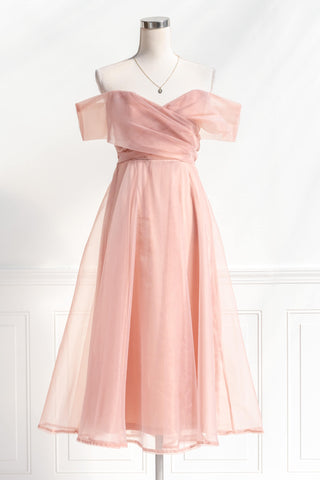From the faintest shade to the most intense hue, the chromatic variety of the color pink is stunning. From one extreme to the other, you'll find there are many lovely shades and an entire aesthetics behind the color. Following is a brief overview of pink, its unique aesthetic, and history!
Etymology

In many languages, pink is exclusively associated with the rose flower. In Italian (rosa), Spanish (rosado-a), French (rose), & German (rosa). English is the only language to associate the color to a different flower: the dianthus.*
A Brief History
The color pink and its aesthetic has been loved for centuries. From old civilizations to today's catwalks, pink has been important in western culture, aesthetics, and fashion. Today, pink has come to represent femininity, beauty, grace, and strength.


In ancient Greece the color was associated with Aphrodite, the goddess of love. Later in ancient Rome, it was used to dye garments used by royalty. By the middle ages it was viewed as a symbol of wealth and high status.

In the 18th century the color was used more widely; it was during this time that it began to represent femininity and grace. This trend persisted in the 19th and 20th centuries.
From Madame de Pompadour, after whom the lovely shade "Rose Pompadour" is named, to several American First Ladies, Princess Diana, and Barbie herself, many women have had a special relation with pink and its aesthetic. Pink clothing, and pink style is here to stay.


The color represents strength too, as seen during the 60's and 70's when the color was used as a symbol for the fight for women's rights. Even today, pink is present in major protests in many parts of the world. The color stands to signify happiness, innocence, as well as hope --as in the use of pink ribbons associated with women's health today.
Pink Paradox
Though opinions on colors are always subjective, one thing is clear: the color's paradoxical nature. For instance: it has been perceived as soft yet strong, innocent yet sensual, and refined yet rebellious.
Surprisingly still, despite its ubiquitousness in fashion and interiors, when asked in surveys, few people state pink as their favorite color!** Maybe they weren't thinking in pink at the moment!
Pink for Girls...
As we've seen in this very cursive article, the rich history of pink should transcend that basic dichotomy that holds "pink for girls - blue for boys". It's too facile. As Valerie Steele, author of the book: "Pink: The History of a Punk, Pretty, Powerful Color" is quoted as saying:
"pink is going through a generational shift... Society is increasingly moving away from the idea of it as a childish, over-sexualized hue. There's a shared recognition that pink can be pretty and powerful, feminine and feminist... We're re-framing pink."***
We can attest that this tension is what makes the color pink all the more fascinating! We also celebrate the inclusivity of pink in modern fashion.
Pink Flowers



To go back to nature’s own color palette, just think of the wide array of lovely pinks seen in the rose, hibiscus, tulip, dahlia, peony, Japanese cherry blossom, and of course: the namesake behind the etymology of the word "pink": the dianthus.
Pink Dress Aesthetic






The pink aesthetic, or at least how we perceive it, is pictured in our Pinterest "La vie en pink" board. There, we've pinned some of our favorite pink dresses, tops, and accessories to complete the board's mood.
Overall, to achieve an elegant pretty-in-pink look, it's best when pink clothing is used either as an accent or as a statement, and paired with white, some pastels, black, or other shades of pink for a monochromatic ootd.
---
We hope you've enjoyed this brief overview of pink and the aesthetics behind the color! Pink clothing, pink dresses, and accessories is what we love!
We leave you with a list of notable pink dresses of the 20th c. and a list of unique shades of pink.
Pink Icons
Iconic pink dresses and the women who wore them in the 20th century:
- Princess Diana's many pink dresses and her storied predilection for the color.
- Marilyn Monroe's pink dress when she sang "Diamonds are a Girl's Best Friend" in "Gentlemen Prefer Blondes", designed by William Travilla (1953).
- Grace Kelly's pink dress while performing in "To Catch a Thief", designed by Edith Head (1955).
- Jackie Kennedy's many pink dresses and outfits (1960's...).
- Audrey Hepburn's one of many pink outfits by Givenchy in "Breakfast at Tiffany's" (1961).
- Jennifer Grey's pink ball gown in "Dirty Dancing" designed by Hillary Rosenfeld (1987).
- Madonna's "Material Girl" pink dress (1984).
Storied Pinks
Seven shades of pink with their own lore and provenance:
- Amaranth Pink - Of Greek origin meaning "unfading flower".
- Barbie Pink - After Mattel's beloved doll.
- Magenta - After an actual town in Northern Italy.
- Rose Pompadour - Attributed to Madame de Pompadour (1757).
- Sakura Pink - After the Japanese cherry blossom.
- Shocking Pink - Attributed to Italian designer Elsa Schiaparelli.
- Tickle me Pink - Formulated by Crayola in 1993.

References:
* The etymology of the word "pink" appears to be traceable to the flower dianthus as stated above, or it can be in relation to the verb "to pink", as in "pinking shears", or a derivation of the old Dutch word for "small". The pink dianthus has small pinked petal edges. Source: etymonline.com.
** Source: Eva Heller: "Psychologie de la couleur : effets et symboliques." Ed. Pyramyd, 2009.
*** Source: https://www.cnn.com/style/article/history-of-color-pink/index.html
Photography Credits: Flower photos: Unsplash. All historical photos used in this article are part of the Creative Commons / OA Domain. All other photos are Amantine copyrighted.


Our collection of Pink Aesthetic Dresses and pink clothing is limited, affordable, and sells fast. Our aim at Amantine is to curate thoughtful collections to spark your dreams of travel, culture, & adventure.
A M A N T I N E
FRENCH-INSPIRED, ROMANTIC, & FEMININE
Follow us on IG and TikTok @shopamantine for styling inspiration and be sure to sign up for our newsletter below to get 10% off your first order!
HOME PAGE PINK DRESSES











































